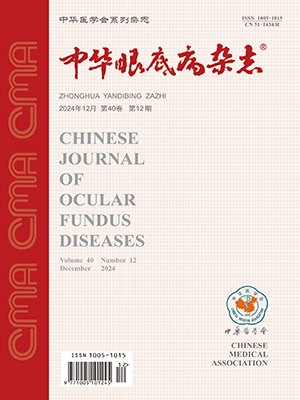| 1. |
Maia OO Jr, Takahashi BS, Costa RA, et al. Combined laser and intravitreal triam cinolone for proliferative diabetic retinopathy and macular edema:one-year results of a randomized clinical trial[J].Am J Ophthamlol, 2009, 147(2):291-297.
|
| 2. |
张风.糖尿病视网膜病变激光治疗的时机与方法[J].眼科研究, 2007, 25(6):401-403.
|
| 3. |
Vogel M, Schäfer FP, Stuke M, et al. Animal experiments for the determination of an optimal wavelength for retinal coagulations[J]. Graefe's Arch Clin Exp Ophthalmol, 1989, 227(3):277-280.
|
| 4. |
Early Treatment Diabetic Retinopathy Study Research Group. Fundus photographic risk factor for progression of diabetic retinopathy:ETDRS report number 12[J]. Ophthalmology, 1991, 98 Suppl 5:S823-833.
|
| 5. |
田蓓, 魏文斌, 朱晓青, 等.全视网膜激光光凝顺序差异对重度非增殖期糖尿病视网膜病变的效果影响[J].眼科, 2011, 20(4):240-243.
|
| 6. |
Tso MOM. Retinal photocoagulation therapy:clinical application and biological basis of therapeutic effects[M]//Tso MOM.Retinal disease.Philadelphia:J.B. Lippincott Company, 1988:247-250.
|
| 7. |
The Early Treatment Diabetic Retinopathy Study Research Group. Techniques for scatter and local photocoagulation treatment of diabetic retinopathy:ETDRS report number 3[J]. Int Ophthalmol Clin, 1987, 27(4):254-264.
|
| 8. |
惠玲, 师晓丽, 王雨生, 等.倍频532 nm激光治疗糖尿病视网膜病变50例[J].国际眼科杂志, 2003, 3(4):46-48.
|
| 9. |
Nagpal M, Marlecha S, Nagpal K, et al. Comparison of laser photocoagulation for diabetic retinopathy using 532 nm standard laser versus multispot pattern scan laser[J]. Retina, 2010, 30(3):452-458.
|
| 10. |
Muqit MM, Gray JC, Marcellino GR. In vivo laser-tissue interactions and healing responses from 20-vs 100-millisecond pulse Pascal photocoagulation burns[J]. Arch Ophthalmol, 2010, 128(4):448-455.
|
| 11. |
Muqit MM, Denniss J, Nourrit V, et al. Spatial and spectral imaging of retinal laser photocoagulation burns[J]. Invest Ophthalmol Vis Sci, 2011, 52(2):994-1002.
|
| 12. |
彭志华, 程谷萌, 吴岚. PASCAL模式扫描光凝治疗糖尿病视网膜病变的疗效观察[J].国际眼科杂志, 2013, 13(8):1639-1641.
|
| 13. |
吴培培, 叶海昀, 钟晓菁, 等.短脉冲模式扫描激光治疗糖尿病视网膜病变疗效观察[J].中华眼底病杂志, 2014, 30(2):152-155.
|
| 14. |
Mahiul MK, Muqit MM, Sanghvi C, et al. Study of clinical applications and safety for Pascal® laser photocoagulation in retinal vascular disorders[J]. Acta Ophthalmol, 2012, 90(2):155-161.
|
| 15. |
Velez-Montoya R, Guerrero-Naranjo JL, Gonzalez-Mijares CC, et al. Pattern scan laser photocoagulation:safety and complications, experience after 1301 consecutive cases[J]. Br J Ophthalmol, 2010, 94(6):720-724.
|
| 16. |
Muqit MM, Marcellino GR, Henson DB, et al. Single-session vs. multiplesession pattern scanning laser panretinal photocoagulation in proliferative diabetic retinopathy:the Manchester Pascal Study[J]. Arch Ophthalmol, 2010, 128(5):525-533.
|
| 17. |
田蓓.糖尿病视网膜病变全视网膜光凝治疗的几个问题[J].眼科, 2014, 23(4):222-225.
|




